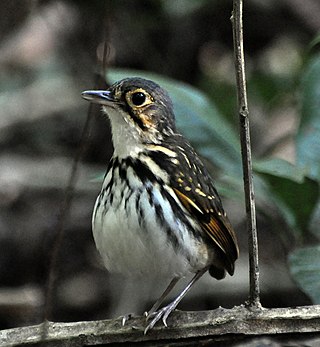
The chestnut-crowned foliage-gleaner is a species of bird in the Furnariinae subfamily of the ovenbird family Furnariidae. It is found in Bolivia, Brazil, Colombia, Ecuador, French Guiana, Guyana, Peru, Suriname, and Venezuela.

The moustached antpitta is a Vulnerable species of bird placed in the family Grallariidae. It is found in Colombia and Ecuador.

The ochre-striped antpitta is a species of bird in the family Grallariidae. It is found in Colombia, Ecuador, and Peru.

The scaled antpitta is a species of bird in the family Grallariidae. It is found in Bolivia, Brazil, Colombia, Costa Rica, Ecuador, El Salvador, Guatemala, Guyana, Honduras, Mexico, Nicaragua, Panama, Peru, Trinidad and Tobago, and Venezuela.

The plain-backed antpitta is a species of bird in the family Grallariidae. It is found in Colombia, Ecuador, Peru, and Venezuela.

The white-bellied antpitta is a species of bird in the family Grallariidae. It is found in Colombia, Ecuador and Peru.

The chestnut-naped antpitta is a species of bird in the family Grallariidae. It is found in Colombia, Ecuador, and Peru.

The undulated antpitta is a bird in the family Grallariidae. It is found in Bolivia, Colombia, Ecuador, Peru, and Venezuela.

The variegated antpitta is a species of bird in the family Grallariidae. It is found in Argentina, Brazil, Colombia, the Guianas, Paraguay, Peru, and Venezuela.

Watkins's antpitta is a Near Threatened species of bird in the family Grallariidae. It is found in Ecuador and Peru.

The ochre-breasted antpitta is a species of bird in the family Grallariidae. It is found in Bolivia, Colombia, Costa Rica, Ecuador, Panama, and Peru.

The slaty-crowned antpitta or slate-crowned antpitta is a species of bird in the family Grallariidae. It is found in Brazil, Colombia, Ecuador, Guyana, Peru, and Venezuela.

The Amazonian antpitta is a species of bird in the family Grallariidae. It is found in Bolivia, Brazil, and Peru.

The thicket antpitta is a species of bird in the family Grallariidae. It is found in Colombia, Costa Rica, Honduras, Nicaragua, and Panama.

The white-lored antpitta or fulvous-bellied antpitta is a species of bird in the family Grallariidae. It is found in Colombia, Ecuador, and Peru.

The spotted antpitta is a species of bird in the family Grallariidae. It is found in Brazil, Colombia, French Guiana, Guyana, Peru, Suriname, and Venezuela.

The streak-chested antpitta or spectacled antpitta is a species of bird in the family Grallariidae. It is found in Colombia, Costa Rica, Ecuador, Honduras, Nicaragua, and Panama.

The tepui antpitta or brown-breasted antpitta is a species of bird in the family Grallariidae. It is found in Brazil, Guyana, and Venezuela.

The buff-fronted foliage-gleaner is a species of bird in the Furnariinae subfamily of the ovenbird family Furnariidae. It is found in Argentina, Bolivia, Colombia, Costa Rica, Ecuador, Panama, Peru, and Venezuela.

The lineated foliage-gleaner is a species of bird in the Furnariinae subfamily of the ovenbird family Furnariidae. It is found in Colombia, Costa Rica, Ecuador, Panama, Peru, and Venezuela.























